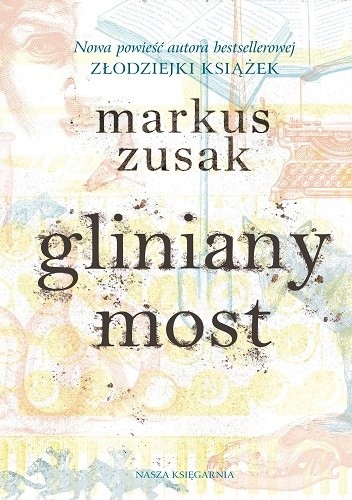„Gliniany most”, Markus Zusak "Bridge of Clay", Markus Zusak
Część pierwsza: 5 braci + zwięrzęta + most
Pięciu braci, papuga, kot, pies, złota rybka oraz muł – tak właśnie wygląda dom rodziny Dunbar na przedmieściach miasta Sydney. Matka, Penelopa (emigrantka z Polski), umarła lata wcześniej, po długim okresie walki z ciężką chorobą. Ojciec, Michael, opuścił ich krótko po tym. Wtedy właśnie zaczęły się pojawiać zwierzęta… i zapanował chaos. Właściwie czego innego niż chaosu można byłoby spodziewać się w takiej sytuacji? Ale najdziwniejsze miało dopiero nastąpić. Po latach nieobecności, Michael powrócił do domu, który kiedyś dzielił z żoną oraz synami. Złożył młodzieńcom dziwną propozycję: jeden z nich miałby jechać z nim do jego aktualnego miejsca zamieszkania i pomóc mu przy budowie mostu. Po długim namyśle, zgodę wyraża Clayton. Jest to znamienne, ponieważ w języku angielskim zdrobnienie jego imienia, Clay, jest określeniem budulca tejże konstrukcji. Tak więc chłopak wyjeżdża, zostawiając za sobą braci, szkołę, zwierzęta, a także swoją pierwszą miłość – Carey.
Część druga: styl + perspektywa + czas i miejsce
Dla tych, którzy już mieli styczność z twórczością Markusa Zusaka, styl „Glinianego mostu” może wydać się znajomy: podział na części i krótkie rozdziały wygląda podobnie jak w „Złodziejce książek” i „Posłańcu”. Jednak tu widoczny jest element, który nie wystąpił w poprzednich dwóch książkach – gwałtowne zmiany perspektywy oraz czasu i miejsca akcji. Całość opowiadana jest przez najstarszego z braci, Michaela (imiennika ojca). Sceny z aktualnego życia chłopaków przeplatają się z migawkami ich życia z rodzicami, budową mostu, retrospekcjami spotkań Claya z Carey oraz początków jej kariery na wyścigach konnych, a nawet życiorysem Penelopy i Michaela seniora z czasów, kiedy się jeszcze nie znali. Widzimy też jak Clay reaguje na śmierć Carey i powoli dochodzimy do tego, co spowodowało konflikt braci Dunbar z ich ojcem.
Część trzecia: sen?
„Gliniany most” to z pewnością nie jest „zwykła” książka. Czytając ją, można czasem odnieść wrażenie, że autor opisuje jakiś bardzo wyrazisty sen, który miał. Jednak to właśnie dzięki temu ten utwór jest tak dobry. I choć trzeba się dość mocno skupić, aby zrozumieć co dzieje się w danym momencie, bardzo ciężko jest oderwać się od czytania. W polskiej wersji językowej książka ta ma ponad 500 stron, jednak ja „pochłonęłam” ją wyjątkowo szybko i byłam ciężko zaskoczona, kiedy dotarłam do końca. Tak więc mogę z czystym sumieniem polecić to dzieło nie tylko czytelnikom, którzy już znają twórczość Markusa Zusaka, ale także tym, dla których będzie to pierwsze zetknięcie z tym autorem. Miłego czytania!



Zdjęcia okładek polskiego tłumaczenia książki
i jej oryginalnej wersji oraz autora
(z grafiki Google)
Part one: 5 brothers + animals + a bridge
Five brothers, a parrot, a cat, a dog, a goldfish and a mule – that’s how the Dunbar family home in the suburbs of Sydney looks like. Mother, Penelopa (an immigrant from Poland), died years ago, after a long period of struggle with severe illness. Father, Michael, left them shortly after this. That’s when the animals started to appear… and chaos prevailed. In fact, what other than chaos would you expect in such a situation? But the strangest thing was yet to happen. After years of absence, Michael returned to the house he once shared with his wife and sons. He made a strange offer to the youngsters: one of them would go with him to his current place of residence and help him with the construction of the bridge. After long thought, Clayton agrees. This is significant because in English, the diminutive of his name, Clay, is the name of the building material of this construction. So the boy goes, leaving behind his brothers, school, animals, and also his first love – Carey.
Part two: style + perspective + time and place
For those who have already had contact with the work of Markus Zusak, the style of „Clay bridge” may seem familiar: the division into parts and short chapters looks similar to that in „The Book Thief” and „The Messenger”. However, there is one element visible here that did not appear in the previous two books – rapid changes in the perspective as well as time and place of the action. The whole story is narrated by the eldest of the brothers, Michael (namesake of the father). Scenes from the current life of boys are intertwined with snapshots of their lives with their parents, building the bridge, retrospections of Clay’s meetings with Carey and the beginnings of her career at horse races, and even the lives of Penelopa and Michael senior from the times when they did not know each other yet. We also see how Clay reacts to Carey’s death and we slowly come to what caused the Dunbar brothers’ conflict with their father.
Part three: a dream?
„Bridge of Clay” is certainly not an „ordinary” book. While reading it, you can sometimes get the impression that the author describes a very vivid dream that he had. However, it is thanks to this that this work is so good. And although you have to concentrate hard to understand what is happening at the given moment, it is very difficult to break away from reading. In the Polish language version, this book is over 500 pages long but I „absorbed” it very quickly and I was really surprised when I reached the end. So I can recommend this work with a clear conscience not only to readers who already know the works of Markus Zusak but also to those for whom it will be the first contact with this author. Have fun reading!






